George's Park
Houses within 15km of this house
Displaying 37 houses.
Houses within 15km of George's Park
Displaying 37 houses.
| House name | Description | |
|---|---|---|
| Ballyphilip | The seat of the Going family in the 18th and 19th centuries, W. and A. Going were resident in 1814 and Ambrose Going held the property in fee at the time of Griffith's Valuation. The buildings were valued at £30.15 shillings. This house was held by the representatives of B.F. Going in 1906. Buildings are still extant at the site. | |
| Ballinunty House | William Going occupied this house and held it in fee in the mid 19th century when it was valued at £24.10 shillings. In 1894 Slater notes it as the seat of Miss A.J. Going. This house no longer exists. | |
| Coalbrook | A Langley home in the 18th and 19th centuries. The Ordnance Survey Name Books describe the demesne as "nearly one half wood and oranmental ground" in 1838. It was valued at £35.10 shillings in the mid 19th century when held by Henry Langley in fee. George Langley was the occupier in 1906 when the buildings were valued at £41+. This house is still extant and lived in. |
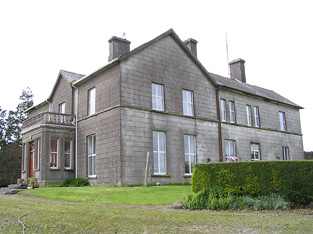
|
| Lisnamrock Castle | The Langleys were resident here from the 18th century. Wilson, writing in 1786, refers to Lisnarock as the seat of Mr Langley. Henry Langley was the occupier in the mid 19th century, holding the property in fee. The buildings were valued at £11.10 shillings. Held by George Langley in 1906. Buildings still exist at this location. | |
| Lickfinn | Fergus Langley occupied Lickfinn in 1814 and John Langley held the house valued at £12 and 273 acres in fee at the time of Griffith's Valuation. This house was later known as Knockanure. In 1906 held by the representatives of John Langley. | |
| Pastor Ville [Kockboy] | In 1840 the Ordnance Survey Name Books refer to Pastorville as a gentleman's seat and to Micheal Meeghan as the proprietor. At the time of Griffith's Valuation Timothy Meighan held a house at Knockboy valued at £10.15 shillings and 15 acres from Edmund Byrne. This appears to be the house Pastor Ville marked on the first Ordnance Survey map and on the later 25-inch map of the 1890s. Buildings are still located at this site. | |
| Littlefield | Littlefield, Killenaule, was the residence of Flor Carrol in 1814 and of E. Cooke "who occasionly resides here" in 1837. Earlier, in 1786, Wilson had referred to it as the seat of Mr. Cooke. Edward Cooke is recorded as the occupier at the time of Griffith's Valuation. He held the property in fee and the buildings were valued at £12. This house is now a ruin. |
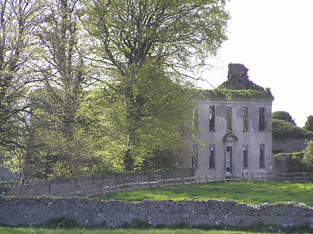
|
| Poyntstown | A home of a branch of the Cooke family in the 18th century. In 1786 Wilson refers to "Point's-town" as the seat of William Cooke. He was also the proprietor in 1814. In 1837 Lewis records Poyntstown as the property of Phanuel Cooke "in ruins". The house is marked as in ruins on the first Ordnance Survey map. Fennell Cooke held this townland at the time of Griffith's Valuation. | |
| Cleragh House | William Power was living at Cleragh, Killenaule in 1814 and Charles Blackmore was resident in the mid 19th century. Blackmore held the house valued at £13 from Patrick Waldron with 257 acres. This house is still in use as a country residence. |

|
| Glenview | Glenview was occupied by the Reverend Edmund Prendergast in the early 1850s. He held the house valued at £18.15 shillings from Matthew Prendergast. In the early 20th century the house was altered and extended by a religious order who set up a school. |
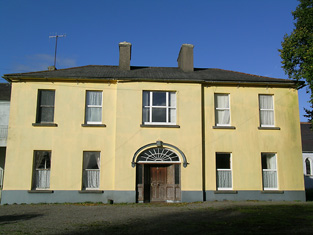
|
| Grangehill | Robert Mason held a house and office valued at £15.10 shillings at Grangehill from William P. Barker in the mid 19th century. Mason was Barker's agent. He also held offices and 101 acres in the neighbouring townland of Knockatooreen. | |
| Kilcooly Abbey | In 1786 Wilson refers to Kilcooley as the residence of Sir William Barker. This was the seat of the Barker and later Ponsonby Barker family in the 18th and 19th centuries. It remained in the possession of the family now known as Ponsonby until the early 21st century. The present house dates from the late 18th century, the family having previously lived in the old abbey. The house was partially destroyed by a fire in 1839 and rebuilt. In the mid 19th century the house was valued at £67.10 shillings. |

|
| Wilford | Wilford was the residence Butler Esq in the 1770s and 1780s and of Mr Richard Blackmore in 1814. In the early 1850s it was occupied by John Blackmore, who held the property valued at £11+ from William P. Barker with 128 acres. The house is labelled Wilford House on the 1st edition Ordnance Survey map but as Shangarry House on the 25-inch edition of the 1890s. It is now a ruin. | |
| Willmount | Occupied in 1814 by Robert Lane and by Hampden Lane in the early 1850s, when the house was valued at £17 and held from William P. Barker. This house is still an occupied residence. |
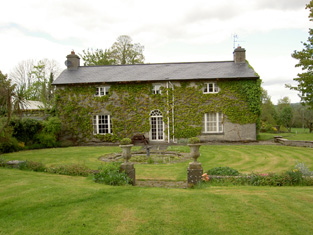
|
| Lanespark | The home of the Lane family from the 18th century,Wilson refers to it as the seat of Hamilton Lane in 1786. Held by John Lane in 1814 and by his representatives in the early 1850s, when the house was valued at £26. The sale rental of 1858 describes the farm offices as extensive and that a powerful steam engine had been erected. Lanespark House is still extant. | |
| Mohober | Mohober was occupied by Scott Esq in the 1770s and 1780s. It was the home of the Cormick family in the 19th century. Richard Cormick was resident in the early 1850s holding the property from the Earl of Clonmel. The buildings were valued at £14.15 shillings. In the 1870s Daniel Cormack of Mohober owned 189 acres in county Tipperary. The sale rental of the interest of James P. Welply in the house and demesne of Mohober dated July 1868 records that the property was conveyed to Daniel Welply by the Encumbered Estates Commissioners in May 1856. The original lease dated 1766 was from William Cane to Mark Scott. The Cormac interest in this property was advertised for sale in June 1876. Buildings are still extant at this site. | |
| Lisheen Castle | Lisheen Castle was the home of a branch of the Lloyd family from at least 1837. Altered and extended by John Lloyd, it was valued at £42+ at the time of Griffith's Valuation and held by John Lloyd in fee. The Lloyd family continued to live at the Castle until the 1880s though Slater refers to it as a seat of Mrs.Lloyd as late as 1894. It was subsequently leased and then in 1918 sold to William Bray O'Brien of Ardfort House, Thurles. When the castle was burnt in 1921 it was the property of O'Brien's daughter and son-i- law Camilla and John Francis O'Meara. In 1994 the ruins were purchased by Joan and Michael Everard who have restored the building which now offers luxury castle accommodation. see http://www.lisheencastle.com/ |
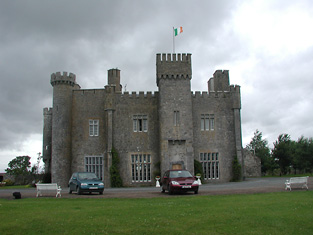
|
| St Kevinsfort | St Kevinsfort was occupied by William Massey [William Creagh Massy?] at the time of Griffith's Valuation. The buildings were valued at £15.17 shillings and held from Usher Beere. In 1840 the Ordnance Survey Name Books refer to the house as the property of Mr. Massy. |

|
| Heathview | This house is marked on the first edition Ordnance Survey map as Liskeveen House. Luke Bray was the proprietor of Liskeveen in 1814. A vacant house valued at £14.18 shillings was in the possession of Samuel M. Going at the time of Griffith's Valuation. A new house located slightly to the south of the original house was built circa mid 19th century. This is the house known as Heathview occupied by Samuel M. Going's daughter Margaret and her husband Owen Lloyd Mansergh in the late 19th century. | |
| Liskeveen [Fannyville] | Originally known as Fanny Ville and marked on the first Ordnance Survey map as such. The Ordnance Survey Name Books refer to it as the residence of Richard Beere in 1840. This house was extended sometime in the mid 19th century and was valued at £30+ when occupied by Samuel M. Going and held by him in fee at the time of Griffith's Valuation. It is still extant. |
![Photo of Liskeveen [Fannyville]](https://landedestates.ie/storage/img/orig/2015.jpg)
|
| Newhill | A property belonging to the Going family in the late 18th and 19th centuries. Newhill was the home of James Going in 1814 and of John Thomas Going, son of Samuel Murray Going, in the mid 19th century. The buildings were valued at £18.12 shillings at this time and held from Christopher Donville. Newhill passed to John Thomas Going's sister Mary Braddell who was resident in 1906. | |
| Riversdale | A house occupied by Patrick Hyland at the time of Griffith's Valuation, held from Usher Beere and valued at £15+. | |
| Parkstown | The Lamphiers were resident at Parkstown from at least the 1770s. In 1786 Wilson refers to Parkes-town as the seat of "Mr. Lanphier". Henry Langley lived at Parkstown in 1814 and John P. Lamphier was resident in 1837 and in the early 1850s. Lamphier held the property from the Court of Chancery and the buildings were valued at £23+. John P. Lanphier was the occupant at the time of sale in 1852. This building is still a fine residence. |
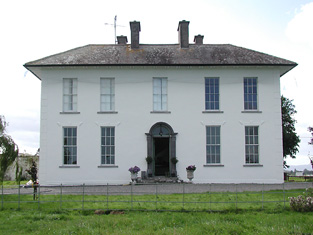
|
| Killoran | Killoran was occupied by Thomas Lalor in 1814 and by Solomon Lalor Cambie in 1837. S.L. Cambie was still the occupier at the time of Griffith's Valuation holding the property from Richard Thompson. The buildings were valued at £17+. The house is still extant. |

|
| Cooleeny Lodge | A house has been located at this site since the first edition Ordnance Survey map of circa 1840. Robert Hunt occupied the house, valued at £11.18 shillings in the early 1850s and held from Henry Langley. A house is still extant at this location. | |
| Archerstown | The home of a branch of the Langley family, occupied at the time of Griffith's Valuation by Henry Langley and held from the Reverend Robert Lockwood. The buildings were valued at £25+. The Langley family continued to live here until the 1970s. |

|
| Fortfield House | Located close to Lisheen Castle, occupied by H. Lloyd in 1837 and by William Butler at the time of Griffith's Valuation. William Butler was married to Catherine Lloyd and held Fortfield, valued at £19+, from his father in law John Lloyd. Home of the Everard family since the mid 19th century. see http://www.lisheencastle.com/?page_id=2 | |
| Rathmanna | Thomas Ryan of Rathmanna died in 1835 and is buried in the graveyard of St Mary's Church, Thurles. Rathmanna house was occupied by Thomas Ryan in the mid 19th century and held from Messrs Waller and Doherty on a lease dated 1791 James Doherty to Thomas Ryan. It was valued at £22.17 shillings. In 1865 it was advertised for sale with about 340 acres belonging to Thomas Ryan. Rathmanna a substanial and spacious house was in the possession of Michael Cahill in 1873. A building is still located at this site. | |
| Ballyduff | Ballyduff was the residence of Hunte Esq in the 1770s. In 1814 J. Minchin occupied Ballyduff, Thurles. In the mid 19th century Benjamin White of Ballyduff held the house valued at £11 and 48 acres from John Hunt. The Hunts and Whites were related. Ballyduff , the estate of John Hunt, was advertised for sale in December 1859 and again in November 1860. The house marked on the 25'' OS map is not on the same site as the original house marked on the first edition OS map. Henry O'Neill of Shanballyduff, Thurles, held 155 acres in the 1870s. The will of Henry O'Neill of Annesbrook, county Dublin and Ballyduff, county Tipperary dated 2 Oct 1891 is in the National Archives (T.12,231). Some of his descendants live in Argentina, see http://www.irishgenealogy.com.ar/genealogia/N/ONeill/henry.htm | |
| Littleton Lodge | Littleton Lodge was the residence of Thomas Ellard in 1814. In 1840 the Ordnance Survey Name Books record it as "the name of a castle, the residence of a gentleman". Charles Wilkinson as the occupier then and in the early 1850s. Wilkinson held the house valued at £17.12 shillings from Mrs Ellard. This house is still a family home. |

|
| Ballydavid | The residence of Marcus C. Russell in 1814 and of John Russell at the time of Griffith's Valuation, when it was valued at £26.15 shillings and held from Edward H. Byrne. The sale rental of 1854 includes a lithograph of this house. It was bought by Richard Power and his descendants continued to live in the house until 1950. The house was demolished in 1963. | |
| Long Orchard | The Lalors were resident at Long Orchard from the mid 18th century. A relative, Edmund Dogherty, was the occupier in 1814. In 1837 Lewis records Richard Lalor Sheil as the proprietor. The Ordnance Survey Name Books in 1840 refer to the house as the residence of the local clergyman, Mr. Thomson. At the time of Griffith's Valuation he held the property from Richard Lalor Shiel when it was valued at £11. The Power Lalor family were still resident at Long Orchard in the early 20th century. Mrs Stella Power Lalor was the occupant in the early 1940s but the grounds and gardens had gone "wild" (Irish Tourist Association Survey).This house is now demolished. | |
| Slievardagh | In 1906 John H. Lanphier held buildings valued at £18+ in the townland of Blackcommon part of the village of Commons, probably Slievardagh House. This house is not marked on the first edition Ordnance Survey map. |
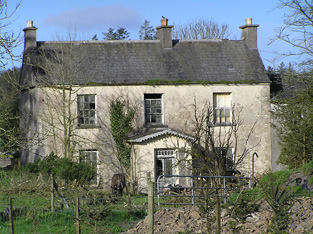
|
| Springhill | Occupied by Dr Samuel Hemphill and held by Samuel Hemphill Esq in fee at the time of Griffith's Valuation when the house was valued at £5.15 shillings. |

|
| Ballymurreen | In 1786 Wilson refers to "Ballymoreen, with the ruins of castle and church" as the seat of Mr. Baker. This townland was described as "in chancery" at the time of Griffith's Valuation. | |
| Coolquill Castle | In 1786 Wilson refers to Coolquill as the seat of Mr. Gahan. The property is labelled "Coolquill Castle" on the 1st edition Ordnance Survey map and indicates that it was built on to a tower house. Coolquill was held in fee by Colonel Palliser in the mid 19th century. He was married to Anne Glenstanes. The castle was valued at £5. The castle ruin and other buildings are still extant at the site. | |
| Venter Fair | The Ordnance Survey Name Books refer to this house in the townland of Clashduff, parish of Ballingarry as "Venture Fair" and note the existence there of coal mines of the same name. At the time of Griffith's Valuation, it was leased by Mrs. Mary O'Sullivan from the Langley estate and valued at almost £10. A house is still extant at the site. |

